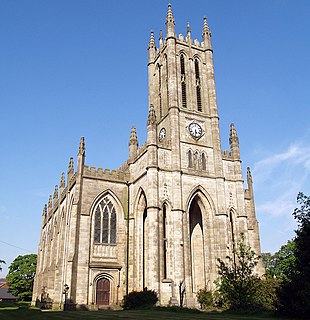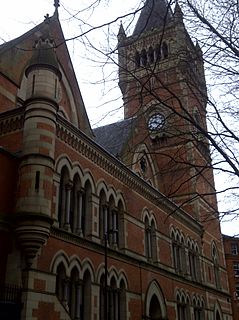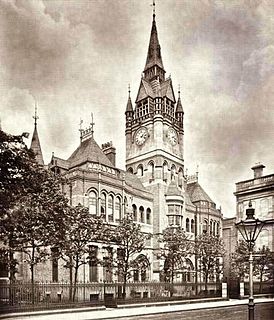
Blackpool Tower is a tourist attraction in Blackpool, Lancashire, England, which was opened to the public on 14 May 1894. When it opened, Blackpool Tower was the tallest man made structure in the British Empire. Inspired by the Eiffel Tower in Paris, it is 518 feet tall and is the 125th-tallest freestanding tower in the world. Blackpool Tower is also the common name for the Tower Buildings, an entertainment complex in a red-brick three-storey block that comprises the tower, Tower Circus, the Tower Ballroom, and roof gardens, which was designated a Grade I listed building in 1973. The tower celebrated its 125th anniversary in May 2019.

New Brighton Tower was a steel lattice observation tower at New Brighton in the town of Wallasey, Cheshire, England. It stood 567 feet (173 m) high, and was the tallest building in Great Britain when it opened some time between 1898 and 1900. Neglected during the First World War and requiring renovation the owners could not afford, dismantling of the tower began in 1919, and the metal was sold for scrap. The building at its base, housing the Tower Ballroom, continued in use until damaged by fire in 1969.

Edward Graham Paley, usually known as E. G. Paley, was an English architect who practised in Lancaster, Lancashire, in the second half of the 19th century. After leaving school in 1838, he went to Lancaster to become a pupil of Edmund Sharpe, and in 1845 he joined Sharpe as a partner. Sharpe retired from the practice in 1851, leaving Paley as the sole principal. In 1868 Hubert Austin joined him as a partner, and in 1886 Paley's son Henry also became a partner. This partnership continued until Edward Paley's death in 1895.

George Gaze Pace, was an English architect who specialised in ecclesiastical works.

All Saints' Church or Stand Church is an active Anglican parish church in Stand, Whitefield, Greater Manchester, England. It is in the deanery of Radcliffe and Prestwich, the archdeaconry of Bolton, and the diocese of Manchester. The church is recorded in the National Heritage List for England as a designated Grade I-listed building. It was a Commissioners' church, having received a grant towards its construction from the Church Building Commission. The church is a tall building, standing on high ground, and is constructed on a platform.

Hubert James Austin was an English architect who practised in Lancaster. With his partners he designed many churches and other buildings, mainly in the northwest of England.

Sharpe, Paley and Austin are the surnames of architects who practised in Lancaster, Lancashire, England, between 1835 and 1946, working either alone or in partnership. The full names of the principals in their practice, which went under various names during its life, are Edmund Sharpe (1809–77); Edward Graham Paley (1823–95), who practised as E. G. Paley; Hubert James Austin (1841–1915); Henry Anderson Paley (1859–1946), son of Edward, usually known as Harry Paley; and, for a very brief period, Geoffrey Langshaw Austin (1884–1971), son of Hubert. The firm's commissions were mainly for buildings in Lancashire and what is now Cumbria, but also in Yorkshire, Cheshire, the West Midlands, North Wales, and Hertfordshire.

St Paul's Church is in Scotforth, a suburb of Lancaster, Lancashire, England. It is recorded in the National Heritage List for England as a designated Grade II listed building. It is an active Anglican parish church in the deanery of Lancaster, the archdeaconry of Lancaster and Morecambe, and the diocese of Blackburn. The architectural historian Nikolaus Pevsner described it as a "strange building" and "an anachronism, almost beyond belief".

The Alhambra was an entertainment complex in Blackpool, Lancashire, England, from 1899–1903. A financial disaster, the building was bought by the Blackpool Tower Company and reopened in 1904 as the Palace. The building was demolished in 1961 to make way for Lewis's department store.

The City Police Courts, now commonly called Minshull Street Crown Court, is a complex of court buildings on Minshull Street in Manchester, designed in 1867–73 by the architect Thomas Worthington. The court was designated a Grade II* listed building on 3 October 1974.

Richard Knill Freeman was a British architect who began his career at Derby and moved to Bolton, Lancashire in the late 1860s. His work, in Victorian Gothic style and typically recalling the Decorated Period of later medieval architecture, can be seen in several cities and towns across the north of England. He worked in total on about 140 buildings, of which about half survive in some form.

The British Muslim Heritage Centre, formerly the GMB National College, College Road, Whalley Range, Manchester, is an early Gothic Revival building. The centre was designated a Grade II* listed building on 3 October 1974.

St Thomas' Church is an Anglican church in St Anne's-on-the-Sea, a town on the Fylde coastal plain in Lancashire, England. It is an active parish church in the Diocese of Blackburn and the archdeaconry of Lancaster. Designed by Austin and Paley, it is recorded in the National Heritage List for England as a designated Grade II listed building.
Joseph Stretch Crowther was an English architect who practised in Manchester. His buildings are mainly located in Manchester, Cheshire and Cumbria.

Harry S. Fairhurst was a prominent architect in Edwardian Manchester. He was responsible for many of the city's iconic warehouses and his commissions include Blackfriars House, headquarters of the Lancashire Cotton Corporation and Arkwright House, headquarters of the English Sewing Cotton Company.

William Owen was an English architect who practised in Warrington, which was at that time in Lancashire, England. His works were confined to Northwest England. Owen is best known for his collaboration with William Lever in the creation of the soap-making factory and associated model village at Port Sunlight in the Wirral Peninsula. Here he designed the factory, many of the workers' houses, public buildings and the church. Later Owen was joined by his son, Segar, as a partner. On his own, or in partnership, Owen designed houses, churches, banks, public houses, an infirmary, a school, and a concert hall.

Holy Trinity Church in Southport, Merseyside, England, is an Anglican parish church in the diocese of Liverpool and a Grade II* listed building. It was built in the early 20th century, and designed by Huon Matear in free Decorated style. It is constructed mainly in red brick, and has a tower, the upper parts of which are in elaborately decorated stone. Many of the internal furnishings are by the Bromsgrove Guild.

Southport Arts Centre, formerly known as Cambridge Hall, is on the east side of Lord Street, Southport, Sefton, Merseyside, England, and stands between Southport Town Hall and the Atkinson Art Gallery and Library. It was built in 1873–74 and originally contained an assembly hall. The centre contains mixed architectural styles and has a tall clock tower at the right end. During the 20th century the assembly hall was converted into a theatre, and it forms part of the arts complex known as The Atkinson. The arts centre is recorded in the National Heritage List for England as a designated Grade II listed building.



















